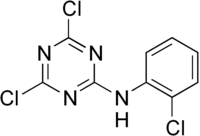Anilazine (ǎ-nǐl-a-zēn) is an organic compound with the chemical formula C9H5Cl3N4. It is a pesticide used on crops. It comes under the category of triazine fungicides. It is used for controlling fungus diseases which attack lawns and turf, cereals, coffee, and a wide variety of vegetables and other crops. It is also used for the control of potato and tomato leafspots.
 | |
 | |
| Names | |
|---|---|
| Preferred IUPAC name 4,6-Dichloro-N-(2-chlorophenyl)-1,3,5-triazin-2-amine | |
| Other names Anilazine (Dyrene);dyrene | |
| Identifiers | |
3D model (JSmol) | |
| ChEMBL | |
| ChemSpider | |
| ECHA InfoCard | 100.002.646 |
| EC Number |
|
| KEGG | |
PubChem CID | |
| RTECS number |
|
| UNII | |
| UN number | 3077, 2588 |
CompTox Dashboard (EPA) | |
| |
| |
| Properties | |
| C9H5Cl3N4 | |
| Molar mass | 275.52 g·mol−1 |
| Appearance | White to light brown crystals or powder |
| Density | 1.611 g/cm3 |
| Melting point | 159 °C (318 °F; 432 K) |
| Boiling point | 365 °C (689 °F; 638 K) |
| 0.0008 g/100mL | |
| Solubility | hexane: .017 g/100 mL methylene chloride: 9 g/100 mL acetone: 10 g/100 mL chlorobenzene: 6 g/100 mL toluene: 5 g/100 mL xylene: 4 g/100 mL |
| Vapor pressure | 2.48x10−5 mmHg |
| Hazards | |
| GHS labelling: | |
   | |
| Danger | |
| H315, H318, H319, H410 | |
| P264, P273, P280, P302+P352, P305+P351+P338, P310, P321, P332+P313, P337+P313, P362, P391, P501 | |
| Flash point | 232.2 °C (450.0 °F; 505.3 K) |
| Lethal dose or concentration (LD, LC): | |
LD50 (median dose) | >5,000 mg/kg |
Except where otherwise noted, data are given for materials in their standard state (at 25 °C [77 °F], 100 kPa). | |
Toxicity
Oral administration to rats and cats, the most common signs of toxicity were diarrhea and vomiting respectively After dermal administration to rabbits mild skin irritation manifested as edema and erythema was observed. Anilazine was more toxic by intraperitoneal injection than by other routes of administration.[1]
Medical use
In 1955, Bergsmann studied dairin as a tuberculocide.[2]
References
External links
- Anilazine in the Pesticide Properties DataBase (PPDB)
🔥 Top keywords: Main PageSpecial:SearchPage 3Wikipedia:Featured picturesHouse of the DragonUEFA Euro 2024Bryson DeChambeauJuneteenthInside Out 2Eid al-AdhaCleopatraDeaths in 2024Merrily We Roll Along (musical)Jonathan GroffJude Bellingham.xxx77th Tony AwardsBridgertonGary PlauchéKylian MbappéDaniel RadcliffeUEFA European Championship2024 ICC Men's T20 World CupUnit 731The Boys (TV series)Rory McIlroyN'Golo KantéUEFA Euro 2020YouTubeRomelu LukakuOpinion polling for the 2024 United Kingdom general electionThe Boys season 4Romania national football teamNicola CoughlanStereophonic (play)Gene WilderErin DarkeAntoine GriezmannProject 2025